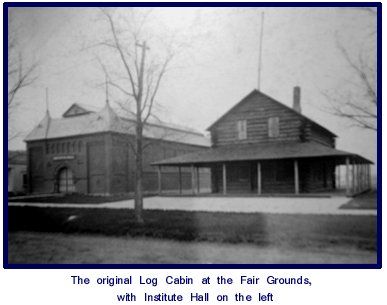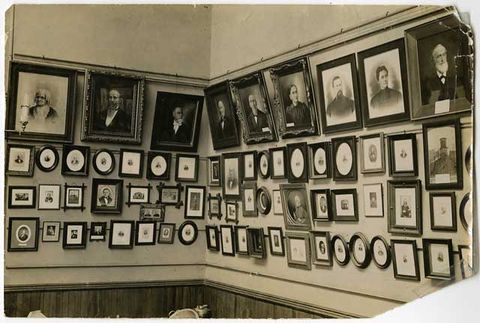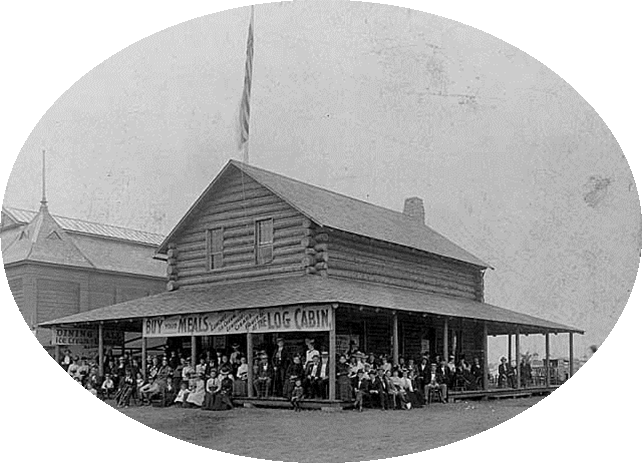Our History
The "Old Settlers", the original name of our organization, was first a loosely knit group that met at Fort Snelling annually at harvest time to exchange experiences with the elements, locusts, and interactions with the local tribes. This usually took place after their crops and produce were sold to traders. The first year that the group decided to call themselves the “Old Settler's Association” was in 1848. It was that year that a meeting was held in the Henry Jackson store at which local and state politicians debated the benefits of creating a new territory to be known as Minnesota. This came to pass a year later. The back room of the Jackson store became their meeting place at irregular intervals until 1850. They then decided they would meet annually at the State Fair which was to be held at Fort Snelling in 1860. From that time on, they met informally at a picnic held on a certain day during Fair time, there were no dues collected, nor were permanent officers elected. This continued for some years.
It was not until May 1897, that the Old Settler's were officially organized and became functioning as a semi-state organization. Their main purpose being to preserve and perpetuate the memory of the early settlers in Minnesota Territory through the collection of artifacts, portraits and records pertaining to life in Minnesota prior to Statehood. Colonel Alvaren Allen, who had been a guiding hand in the loosely knit group, was officially elected our first President. The names of the men who followed as officers of the Minnesota Territorial Pioneers reads as a "Who's Who" in Minnesota history. They were truly ''Maker’s of Minnesota". With the dropping of the name of "Old Settler's Association" and adapting of the new name "Minnesota Territorial Pioneers", a new era began in the history of our group. The first effort was made to find a permanent headquarters for the Pioneers. Inasmuch as the Old Settler's had met at the Fair for many years and also that many members of the State Agricultural Society were, or had been, members of the Old Settler's Association, it was decided at the urging of George H. Hazzard, an Old Settler and County Commissioner, to try to locate our headquarters at the State Fair Grounds. This attempt was successful. The relations between the Fair Management and the Pioneers has been beneficial to both groups ever since.
It should be mentioned here that George H. Hazzard became the Secretary of the Minnesota Territorial Pioneers in 1903. He had been the prime mover for permanently locating the State Fair at its present location, which a portion of was formerly the Ramsey County Poor Farm.
The 1900 State Fair marked a milestone for the Old Settler's. It was that year that construction began on Pioneer Log Cabin. Several members donated their labor and money for this project which was under the Supervision of A. L. Casler. Edwin Clark
organized the project. Members of the Old Settler's Association also landscaped and planted the trees still standing in front of the present Pioneer Log Cabin.
Below is a resolution adopted by the State Agricultural Society of Minnesota at the Annual Meeting held at Saint Paul, January 15-17, 1930:
WHEREAS in the death of George H. Hazzard, secretary of the Minnesota Territorial Pioneer Association and a life member and enthusiastic worker in our own Society (the man to whom more than any other one man is due credit for the location of our present State Fair Grounds upon their splendid site, a man who through many years has given freely of his time and talents toward the upbuilding of our institution) we have lost a true and trusted friend.
BE IT RESOLVED that we hereby express our regret at his passing and extend our deep and sincere condolences to his family,"
I hereby certify that the above resolution was adopted January 17, 1930, by the State Agricultural Society of Minnesota in annual meeting assembled.Dated at Saint Paul, Minnesota (Attest) RAYMOND A,LEE,
January 24, 1930 Secretary
In 1901, the membership of the Minnesota Territorial Pioneers was 1,772; dues were 50¢ per year and Life membership was $1.00.
In 1907, the portrait collection was so large that it was not possible to display even one quarter of them in Pioneer Log Cabin. Our officers and members requested the Fair Board to grant them the use of Institute Hall, which was on the present site of the Ramberg Senior Center, for displaying the Pioneer Portraits. It was a large building with sky-lights and ideal for a gallery. This request was granted. Even though we had a great number of pictures and portraits in our possession, there still was room for many more. Hazzard and Clark got busy working to grow the collection for the next 10-15 years. Institute Hall became Pioneer Portrait Hall and was occupied until the close of the 1957 Fair. The collection grew into the largest and only one of its type in the United States. Many are charcoal drawings and oil paintings.
During the years that followed formal organization, the Territorial Pioneers sponsored many social affairs such as excursions, banquets, picnics and dances. Thursday of Fair Week had been designated Territorial Pioneer Day. On that day a particularly large number of our members joined in a picnic reminiscent of those held by the Old Settler's prior to formal organization.
The business of running the Pioneers was such that the officers decided that for many reasons they should incorporate. This was accomplished in 1924.
1958 marked the 100th anniversary of Statehood. To fittingly celebrate this memorable occasion, the Minnesota Territorial Pioneers staged a gala “Old Time Anniversary Banquet and Dance.” It was well attended by prominent State officials and members. Secretary Alma Elm worked extremely hard and long to make the various celebrations the big success they were.
In 1957 the Fair Board informed our officers they would have to vacate Pioneer Log Cabin and Pioneer Portrait Hall immediately after the closing of the Fair, and all items would have to be placed in storage. This was due to both buildings being condemned by Fire Marshall - the second story of the original two story log cabin was slowly collapsing.
1958 marked the year when the State Fair Board of Managers provided for us a new Pioneer Log Cabin and built a new Pioneer Portrait Hall as well. A cornerstone laying ceremony was held and inside, the Pioneers placed a list of officers and members, application blanks, coins and newspaper articles concerning both the old and new buildings. The buildings were presented to our organization in the early part of August. Readying the two new buildings in time for the opening of the 1958 Fair was done by a lot of hard work and long hours (as it still is today). Afterall, at the time there were 1,800 pictures to clean, repair, and hang.
In 1968, due to the changes in operation and the necessity of updating the Articles of Incorporation and By-laws, the Minnesota Territorial Pioneers filed Articles of Re-Incorporation. The man responsible for the tremendous amount of work connected with the endeavor was Colonel Edwin Skinner, assisted by a committee. We are forever grateful to them.
Below is an excerpt from a letter in regards to our collection written by a non-member to J. Will Bates, Minneapolis, Minnesota, dated May 8, 1930.
For the past 19 years I have visited Pioneer Portrait Hall daily during Fair week. I have thus had a better opportunity than most of you to get reliable information as to the manifest interest of those who visit Portrait Hall or go there to show friends pictures of deceased relatives or persons of historic importance. You cannot imagine how reverent these folks act in the presence of these portraits. Men from nearly every civilized country frequently remove their hats while looking at pictures. Why are they so interested? Hundreds ask questions. Many have shown particular interest in the large variety of frames. How do you account for this manifest interest in pictures of strangers? I think they recall some incident in the lives of these sturdy characters which grip the heartstrings and sets in motion thoughts pleasant to contemplate.
Today, please try to realize more than heretofore that your group are custodians of a historically valuable and unique collection. No other organization can produce; or hand down posterity, as fascinating a memorial to the worthwhile qualities which produced such nobility of character.
The same sentiments of the visitors to Portrait Hall continued up until 1971, when the State Fair Board redesignated Portrait Hall as the Senior Citizen Building. In fact, students of history spent considerable time checking on pictures and came several times during, what was at the time, the ten day period of the Fair.


